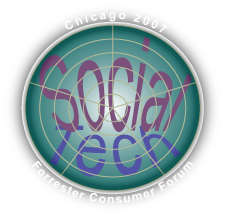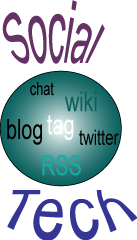How Social Tagging Changes the Economics of Ecommerce was a geeky session that explained how a potent mix of “people like me” navigation and digital leverage can drive sales and profits + The secret to emerging markets?
 The Global Human Capital Journal’s coverage of the Forrester Consumer Forum 2007 continues with this session on social tagging. Before your eyes glaze over, bear with me and learn how this simple, revolutionary social technology can help your customers to help your business. Forrester’s Sarah Rotman Epps moderated a discussion with Brian Rosenblat, Online Retail Industry Lead, Endeca Technologies and Jay Shaffer, Vice President Marketing, PowerReviews, who represented companies that offer social tagging solutions, and they all shared numerous examples.
The Global Human Capital Journal’s coverage of the Forrester Consumer Forum 2007 continues with this session on social tagging. Before your eyes glaze over, bear with me and learn how this simple, revolutionary social technology can help your customers to help your business. Forrester’s Sarah Rotman Epps moderated a discussion with Brian Rosenblat, Online Retail Industry Lead, Endeca Technologies and Jay Shaffer, Vice President Marketing, PowerReviews, who represented companies that offer social tagging solutions, and they all shared numerous examples.
This was one of the most “actionable opportunity” sessions of the conference: tagging is a relatively unknown, simple, yet transformational Web 2.0 phenomenon that will gain traction in 2008 and explode in 2009. If you aren’t doing it, you will be at a significant disadvantage to your competitors who do.
The Global Human Capital Journal published the overall conference wrap as well as in-depth coverage of several sessions. Access all through the link to the conference logo (right).
Social Tagging: What It Is and How It Works
- Tags are digital “post-its” that users put on all elements of content: articles, pictures, videos. These post-its are searchable by the person who “tagged” the content as well as by everyone else (unless the tagger makes it private).
- Many people compare tags to bookmarks, but this underrates tags in two ways: 1) one page has one bookmark, while you can put as many tags as you want on a page, or on part of a page; 2) browser bookmarks live in folders, but tags are far more accessible because they live in clouds, and tagging systems have superior search and browse capabilities.
- Users tag things to make them easier to find (again think of post-its or highlighting in a book or magazine). When you install a tagging solution, users can tag pages, pictures, videos, podcasts with a combination of existing tags and their own tags. Creating or using a tag is a one-click process, so it’s easy. People do it.
- Search engines use software algorithms, but they are limited in “seeing the forest for the trees.” They have no sense. There were some humorous examples of search result gaffes, like Marriott’s number one suggestion to a North American user for a “romantic hotel” was in—Yerevan, Armenia. With tagging, real people have viewed the content, reacted to it and categorized it for other people. Notably, customers do this on their own time, at no minimal marginal cost to the Website.
- 22 million of online consumers self-identify as taggers, but they fit the model of typical technology early adopters (technology enthusiasts, entertainment-oriented, male). This probably indicates that tagging will probably become much more mainstream in the coming years.
- Some major sites that use social tagging are: ACE Hardware, Amazon.com, Brookstone, RadioShack, Sheraton, Staples, Toys “R” Us, Walgreens and Yahoo! Travel.
How Social Tagging Relates to Selling Online
Social tagging is of high interest to e-commerce sites because it can help to increase average sale by better matching the right product with the right customer and increase profitability by decreasing returns. Tagging is currently used for two main purposes: 1) to support alternative categorization and navigation and 2) to organize and monetize user-generated content. Tagging is especially powerful when it is seamlessly combined with customer reviews. Brian’s and Jay’s companies often work together to provide such an offering.
 Social tagging is especially useful when selling a vast array of products, when choice is overwhelming for customers (think amazon.com or an office supply site).
Social tagging is especially useful when selling a vast array of products, when choice is overwhelming for customers (think amazon.com or an office supply site).- Yahoo! Trips recently added tagging as a way to make its one million user-created Trip Plans more organized and accessible. It recommends destinations based on Trip Plan tags, combined with user profiles and behavior. Prior to user tagging, the trips were not very accessible and added little value to the site.
- Tags supplement Website navigation. They can lead people to find exactly what they want more quickly, and this increases the average sale because customers can search “in their own language” (because tags are customers’ language).
- Tags let users find products in new ways: user-generated tags are searchable: for example, “chick lit” is a tag that has been used for many products on amazon.com. People can tag in their own language, and the combinations of tags are powerful digital breadcrumbs.
- Users will often share what they use products or services for, and what they like/don’t. Companies can use tags for real-time customer surveys (i.e. “I use this product for a, b, c or d” where these are tags). Companies can use this information to significantly impact sales by tweaking descriptions. The Web, unlike other marketing, enables companies to experiment quickly.
- Companies use social tagging to increase customer insight and set customer expectations (through customer reviews) to decrease returns. Because customers have a better idea of a product’s strengths/weaknesses, they are less likely to buy and return and they are more willing to buy because they feel more confident.
- Additionally, solutions like Endeca analyze tags on the fly and offer alterative navigation that appears as a type of sub-navigation. This is revolutionary because it enables emergent navigation that it partially guided by other customers’ tags. Moreover, it is all digital and very inexpensive for the company.
- Here are some examples: Buzzillions.com,
Analysis and Conclusions
- Tagging is an elegant, powerful way to let customers guide other customers—asynchronously. Customers offer free advice to their customers.
- In many categories, user-generated content (UGC) is increasing significantly. As the Yahoo! Travel example showed, UGC can be difficult for companies to work with because they didn’t create it and may not understand it. Other customers are often very willing to organize it and categorize it for companies.
- Tagging is a technique to standardize communication: tags are interchangeable, reusable building blocks that people combine to express their opinions. Since they are digital, software can analyze and infer conclusions via sophisticated algorithms.
- Although tags are standardized, they are infinitely extensible: people create their own tags on the fly.
- In many cases, customers are far better qualified than company employees to help other customers—because they are necessarily customer-focused. A customer who tags a cell phone will use tags to describe the phone in a much more realistic way than a product manager will.
- Tagging is inherently social, and it undoubtedly increases website stickiness. It is a simple way to let customers give something of themselves, thereby investing in a site and developing a stronger bond with it. When combined with reviews, shopping becomes much more social. Customers’ voices make Websites more human and enjoyable and effective.
- If this weren’t enough, think about the killer app: social tagging is the way to enter emerging markets. Product introduction teams conduct expensive studies but cultural differences and gaffes increase risks tremendously. Tagging enables your customers to help each other. Moreover, in emerging markets, new middle classes are primarily knowledge workers and are online and excited about the online world by default.
- To learn more, get into the act by tagging this article in del.icio.us; here are my del.icio.us tags for Social Tagging; or email me. Also notice that blogs, wikis and all social Websites have tagging functionality built in. In Global Human Capital Journal, for example, each article is tagged, and you can search articles by clicking on tags; moreover, you can subscribe to tags via RSS, but that’s another geeky discussion. If you want to learn more about how that works, see the GHCJ’s Tools page.

Fantastic posting and detailed write-up of what I thought, too, was a fantastic panel sessions. There was some great examples of tagging going on out there including, of course, PowerReivews’ unique tag-based approach to customer reviews and the synergistic power that is derived when that functionality is paired with site navigation as in the case of Endeca guided navigation capabilities – we call this Social Navigation.
Through the use of tags derived during the review process, shoppers can now personalize their shop and browse experience and look for products based on the specific attributes best uses of even by recommendations from people just like them with similar interests. With Social Navigation shoppers are breaking the barriers with standard site navigation and its matrix approach to presenting products by category and sub-categories and can, for example, simply look for shoes that are comfortable, great for travel and durable – all user generated tags!
The Forrester Consumer Forum is talking tagging, and the Global Human Capital Journal is listening. I really enjoyed their take on it, but had one minor complaint: they assert,
… customers [tag] on their own time, at no cost to the Website.
Jay, thanks for the feedback and additional examples. I was just thinking.. our readers are very familiar with reviews and somewhat less knowledgeable about tagging, and during the session I could see a lot of synergy when tagging and reviews are used together. Can you point us to a piece that gets us under the hood (not too technical) of how the synergy plays out? It might look like:
V(tagging itself) x V(reviews itself) = V(soc.nav both)
IOW, what unique extra value do we get by using both?
[…] How Social Tagging Changes the Economics of Ecommerce: Customers Help You to Boost Revenue—social tagging will be extremely powerful way to let customers help you to generate higher returns on your Web assets, externally and internally, and this article will explain how it works. […]